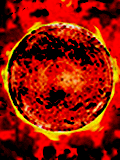Organic Lesson 64 "Organic Synthesis"
Science and Technology Standards:
PA Standard 3.4.12A: Apply concepts about the structure and properties of matter.
Anchor Assessment S11.A.3.3: Compare and Analyze repeated processes or recuring elements in patterns.
Anchor Assessment S11.C.1.1: Explain the relationship between the structure an properties of matter.
Purpose:
1. I will identify the oxidation and reduction products of benzene.
2. I will draw the resonance forms of polycyclic aromatic hydrocarbons.
3. I will propose immediate precursors to synthesize organic compounds.
Homework Due:
1. Complete notes on sections 5.9 - 5.11
2. Complete problems 5.14 - 5.16
Handouts/Supplies:
1. No handouts
I. Introduction
Opening Assignment:
Warm-Up: Draw the acylation mechanism.
Review warm-up
State the purpose
II. The Lesson:
Activity #1: Review the acylation mechanism
Activity #2: Review problems 5.14 - 5.16
Activity #3: Review section 5.9 "Oxidation and Reduction of Aromatic Compounds"
Activity #4: Discuss the following:1. Oxidation of alkyl groups on benzeneActivity #3: Review section 5.10 "Polycyclic Aromatic Compounds"
2. Read question 4.55 "On hydrogenation under conditions that reduce aromatic rings, . . ."
3. Reduction of an aromatic ring deactivator
4. Convert 2000 psi into atmospheres of pressure (14.6 psi = 1 atm)
Activity #4: Discuss the following:1. Resonance structures of AnthraceneActivity #3: Review section 5.11 "Organic Synthesis"
2. Benz(a)pyrene becomes a diol epoxide
3. Hybridization of Nitrogen in Pyridine and Pyrrole
Activity #4: Discuss the following:1. All aromatic reactions (Halogenation, Nitration, Sulfonation, Alkylation, Acylation, and Reduction), alkyl oxidation, and alkylation limitations (-NO2, -SO3H, -CN, -COR)Activity #5: Complete problems 5.17 - 5.21
2. Review ortho-/para- and meta- directors
3. Review activators and deactivator
4. Working backwards
III. Closure:
Summary Assignment:
Summarize today's lesson
1. I will identify the oxidation and reduction products of benzene.
2. I will draw the resonance forms of polycyclic aromatic hydrocarbons.
3. I will propose immediate precursors to synthesize organic compounds.Homework Assignment (Write down in planners):
1. Complete problems 5.17 - 5.21
Preview of Next Class:
1. Electrophilic Aromatic Substitution Reactions: Bromination
2. Other Electrophilic Aromatic Substitution Reactions

